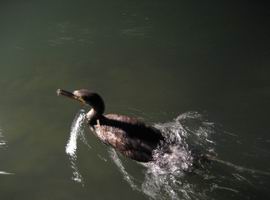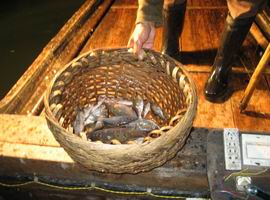Home » Activities » Yangshuo
Cormorant Fishing


Cormorants are 2 to 3 ft (61 to 92 cm) long, with thick, generally dark plumage and green eyes. The feet are webbed, and the bill is long with the upper mandible terminally hooked. Expert swimmers, cormorants pursue fish underwater.
Fishing with birds is an old tradition, since ancient times in China, cormorants have been tamed and trained to catch and bring back fish to their owners. Training starts when the young birds are fully grown and feathered.
The cormorant plunge into the river and catch fish, they can not swallow the fish because their throat is bound by metal collars, (When their work is done the rings are removed so they can eat.) and the fisherman sit in stern of the boat to collect the catch. The boats are flat, narrow rafts consisting of five or six large, round bamboo trunks tied together and upturned at the stern.
When the evening is coming, a large number of bamboo rafts, the fishermen light the lantern to draw fish, they catch fish 3, 5 hours, even sometimes the whole night. The next day their wives sell fish in the local market while husbands catch fish at night. There are many lanterns on the bamboo rafts just like the stars in the sky. It is amazing. Sometimes you can see the cormorant shining under the lanterns. The fisherman sails slowly on a small boat with trained cormorant birds swimming around the boat. A piece of string is tied around the birds throat so the bird can't swallow. So the cormorant swims and catches fish and stores them in their mouth. One by one the fisherman hooks the bird on a stick, and empties the mouth filled with fish and then puts the bird back in the water to continue the fishing technique! So we followed the boat and watched under torchlight, this unique and clever way of fishing... an atmospheric and interesting boat ride.
One good cormorant can catch enough fish to support an entire family.
The cormorant fishing starts at 7:30 pm for about 45 minutes each night.



